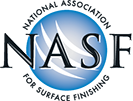| Presented in Partnership with: | |||
 |
 |
 |
 |
MEMORANDUM
SUBJECT:
Use of Wetting Agents in Trivalent Chromium BathsFROM:
John B. Rasnic, Director
Manufacturing, Energy and Transportation Division
TO:
Susan Studlien, Deputy Director
Office of Ecosystem Protection
Region I
This memorandum is in response to a November 25, 1996, letter from Stanley Hardware to Susan Lancey of your staff. Stanley Hardware has requested a clarification of section 63.342(e)(1) of the National Emission Standard for Chromium Emissions from Hard and Decorative Chromium Electroplating and Chromium Anodizing Tanks (Chrome Plating NESHAP).
Section 63.342(e)(1) states that facilities that use a trivalent chromium bath that incorporates a wetting agent as a bath ingredient are subject to recordkeeping and reporting requirements but are not subject to the work practice requirements in section 63.342(f) or the continuous compliance monitoring requirements in section 63.343(c). Section 63.342(e)(1) also states that "[t]he wetting agent must be an ingredient in the trivalent chromium bath components purchased from vendors." Stanley Hardware has inquired whether the vendor must supply the user with a pre-mixed bath mixture containing the wetting agent.
The intent of the language in section 63.342(e)(1) is to exempt from work practices those facilities that use trivalent chromium baths, if the bath components were purchased from a vendor who includes the wetting agent as an integral component of the bath solution. The bath mixture does not have to contain the wetting agent when purchased from the vendor. The common practice is for the vendor to sell the user the wetting agent along with other necessary components of the bath as a total package. The language in the preamble to the Chrome Plating NESHAP may be confusing where it states that "the wetting agent is part of the plating solution purchased from the vendor, it is not added separately by the end user", (see Federal Register Vol. 60, No. 16, January 25, 1995, p. 4955). The intent of the preamble language is to again state that the wetting agent is purchased from the vendor as a necessary component of the bath; it is not purchased separately from another source.
In closing, Section 63.342(e)(1) does require the trivalent chromium bath solution components to include a wetting agent. However, the wetting agent does not need to be incorporated into the bath solution by the vendor. The wetting agent must only be included as an integral part of the trivalent chromium bath components when purchasing the solution components from the vendor. The wetting agent can then be added by the source following vendor recommendations. The source would still be exempt from the work practice requirements and the continuous compliance monitoring requirements. If you have any questions regarding this issue, please call Scott Throwe of my staff at (202) 564-7013.
 |
 |
 |
 |
 |
| Home | Subscribe | Regulations | Compliance Assistance | News | Resources | Resource Locators | Directories | Online Training | About | Search | NASF.org |
The information contained in this site is provided for your review and convenience. It is not intended to provide legal advice with respect to any federal, state, or local regulation.
You should consult with legal counsel and appropriate authorities before interpreting any regulations or undertaking any specific course of action.
Please note that many of the regulatory discussions on STERC refer to federal regulations. In many cases, states or local governments have promulgated relevant rules and standards
that are different and/or more stringent than the federal regulations. Therefore, to assure full compliance, you should investigate and comply with all applicable federal, state and local regulations.